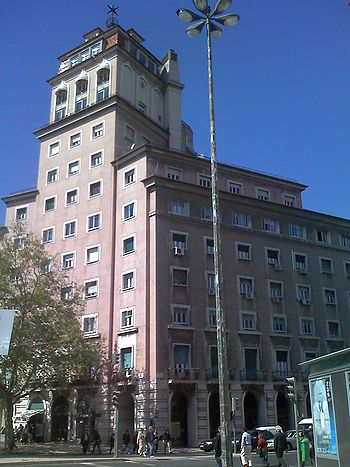
Soft Portuguese style
Encyclopedia


Portugal
Portugal , officially the Portuguese Republic is a country situated in southwestern Europe on the Iberian Peninsula. Portugal is the westernmost country of Europe, and is bordered by the Atlantic Ocean to the West and South and by Spain to the North and East. The Atlantic archipelagos of the...
, essentially during the 1940s and the early 1950s. This architectural style is also known as Nationalistic style, Traditionalistic style and New State style, but this last denomination is not very correct, since during the Portuguese New State Regimen diverse architectural styles have been applied in public buildings.
History
Portuguese Suave was the result of the ideas of several Portuguese architects who, from the beginning of the 20th century, looked to create "genuine Portuguese Architecture". One of the mentors of this style was the architect Raul LinoRaul Lino
thumb|200px|right|House of Casa da Quinta da Comenda, palace built in a rock over the ocean in 1903Raul Lino da Silva, better known as Raul Lino was a Portuguese architect....
, creator of the theory of the "Portuguese house". The result of this current was the creation of a style of architecture that used the modernist engineering characteristics, masked by a mixture of exterior aesthetic elements borrowed from the ancient and traditional architecture of Portugal.
The Portuguese New State, an authoritarian nationalist regime resulting from the 1926 revolution and led by Oliveira Salazar, embarked upon a wide-ranging public works policy, beginning in the 1930s. Initially, in new public buildings, a monumental modernist style prevailed, with Art Deco
Art Deco
Art deco , or deco, is an eclectic artistic and design style that began in Paris in the 1920s and flourished internationally throughout the 1930s, into the World War II era. The style influenced all areas of design, including architecture and interior design, industrial design, fashion and...
characteristics. However, after the Portuguese World Fair in 1940, whose chief architect was Jose Cottinelli Telmo, the Portuguese Government started to prefer a nationalistic style for its new public constructions. This style was used in all types of public buildings, from small rural elementary schools to big secondary schools and university campuses, military barracks, courts of justice, hospitals, town halls and so on.
Beyond Portugal, this style was also wide used in public buildings of the Portuguese overseas territories of Africa
Africa
Africa is the world's second largest and second most populous continent, after Asia. At about 30.2 million km² including adjacent islands, it covers 6% of the Earth's total surface area and 20.4% of the total land area...
, Asia
Asia
Asia is the world's largest and most populous continent, located primarily in the eastern and northern hemispheres. It covers 8.7% of the Earth's total surface area and with approximately 3.879 billion people, it hosts 60% of the world's current human population...
and Oceania
Oceania
Oceania is a region centered on the islands of the tropical Pacific Ocean. Conceptions of what constitutes Oceania range from the coral atolls and volcanic islands of the South Pacific to the entire insular region between Asia and the Americas, including Australasia and the Malay Archipelago...
. The style was also very popular in the private sector, being used in all types of buildings, from the small family homes to blocks of flats, hotels, office blocks, commercial and industrial buildings.
The style was severely attacked by a great number of young architects who accused it of being provincial and devoid of imagination. Its nickname, by which it was most commonly known, "Portuguese Suave", was given to it ironically by its critics, who had compared it to a brand of cigarettes of the same name. The biggest blow to the style was struck by the 1948 1st Portuguese National Congress of Architecture, which meant that it gradually came to be abandoned for both public and private works. From the mid-50s, state-sponsored public works started using more modernist architectural styles.
Despite criticism by many intellectuals, the Portuguese Suave style proved to be popular, corresponding to the tastes of a segment of the Portuguese people. Its characteristics, although attenuated, have returned and can be seen in numerous private buildings built since the 1990s.
Characteristics
Typical buildings of the Portuguese Suave style used modern engineeringEngineering
Engineering is the discipline, art, skill and profession of acquiring and applying scientific, mathematical, economic, social, and practical knowledge, in order to design and build structures, machines, devices, systems, materials and processes that safely realize improvements to the lives of...
techniques, making use of concrete
Concrete
Concrete is a composite construction material, composed of cement and other cementitious materials such as fly ash and slag cement, aggregate , water and chemical admixtures.The word concrete comes from the Latin word...
structures with a high build quality. However, in contrast to modernist buildings, modern techniques and lines were hidden using ornamental elements.
The ornamental elements in the style were borrowed from the architecture of the 17th and 18th centuries and from regional Portuguese architectural styles. Typically, decorative elements such as rough rock, peaked tiled roofs, pinnacles, pilasters, balconies, etc were used. Many, especially larger building, also had arches and towers topped with nationalistic symbols such as armillary sphere
Armillary sphere
An armillary sphere is a model of objects in the sky , consisting of a spherical framework of rings, centred on Earth, that represent lines of celestial longitude and latitude and other astronomically important features such as the ecliptic...
s.

